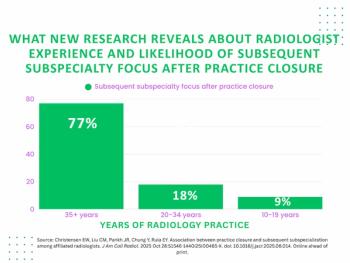
What to Do When Facing a Medical Malpractice Lawsuit
What you can expect and the steps you should take.
When you’re reading images, the first thing on your mind is making the most accurate diagnosis for your patient. It’s unlikely you’re worried about whether you’ll be sued for the work you performed that day.
And, if you do think of the word malpractice, chances are specialties like surgery or obstetrics & gynecology-the two most commonly sued practitioners-jump to mind. As a provider with limited patient interaction, you might think you’re relatively safe from any accusations of wrong-doing or incompetence. But, that’s not the case.
According to a 2016 Journal of the American College of Radiology
Related article:
“In general, when a radiologist is brought into a malpractice suit, it is because something adverse happens to a patient,” says John McGahan, MD, professor of radiology and vice chair of academic affairs for the University of California-Davis Health radiology department. “Whether there is malpractice or there’s a breach of duty, the patient is often angry at whatever the outcome is, and they’ve sought out attention from a lawyer.”
Usually, he says, the problem is a radiologist fails in detection or in their interpretation of certain findings. Or, the issue might be a break-down in how results are communicated from radiologist to referring provider.
Whatever the case, if you’re contacted about a lawsuit, you might be confused about what to do next. According to industry experts, there are several steps you should take whether you’re the only provider named or if you’re part of a group of practitioners. But, most importantly, they say, don’t try to go it alone.
Receiving a subpoena for a malpractice case can be surprising and confusing, especially if you feel you’ve done your best work. However, once you receive notice you’ve been named in a malpractice suit, there are a few things you should do, says Jonathan Mezrich, MD, JD, a radiologist with the Yale University School of Medicine.
What should you do when faced with a malpractice lawsuit?
- Contact risk management: If you work in a hospital system, your first step must be contacting your risk management office. The staff will connect you with an in-house or on-staff lawyer who can provide you with proper guidance. If you work in a private practice, and your office doesn’t already retain a lawyer, you’ll need to seek out a skilled defense malpractice attorney. He or she will have several detailed questions for you to answer.
- Review medical records: You need to be as well-versed about the case as the plaintiff, so immediately review the medical records associated with the case to determine what happened, how much was documented, and how you communicated your findings to the referring physician.
- Know the guidelines: If you’re being accused of missing a diagnosis or not following protocol, ensure you’re knowledgable about all the guidelines surrounding the work you performed. This includes not only the American College of Radiology guidelines, but also any standing protocols your practice follows. For example, your group might have a guideline to always look at the gallbladder or portal vein as part of an abdominal ultrasound. Be sure you’re following these procedures.
- Participate in deposition: After you’ve reviewed the medical records with your attorney, you’ll give a deposition where you provide testimony under oath about your interactions with and work for the patient. Don’t participate in the deposition process without your attorney present. Having legal representation with you throughout all parts of the malpractice process is critical.
- Follow your attorney’s lead: At every step, it’s vital you follow your attorney’s instructions. He or she knows the legal ramifications of any actions and can help you successfully navigate a malpractice suit.
What should you avoid?
One of the riskiest things you can do during a malpractice suit is talk, Mezrich says. Once you’ve received notification you’ve been named in a lawsuit, limit your conversations about the topic to your attorneys.
And, as tempting as it might be to say you’re sorry for what happened, you should resist the urge, he says.
“Certainly, admitting fault before talking to someone is a bad idea. I would make sure everyone was on board with what you need to say before you do it,” he says. “You don’t want to go to the plaintiff and say ‘I screwed up’ and, then, come back to your lawyer and have her say she can’t defend your case now.”
Some states do have apology laws that allow doctors to apologize to patients with the understanding such statements won’t be used in a malpractice case. But, these laws don’t exist in every state. Consequently, many attorneys caution radiologists against directly apologizing to a patient.
McGahan agrees. Limit your discussions of the case and any of its details to your conversations with your attorney.
“You should avoid open discussions with everyone about your case,” he says. “Any talk of it should be fairly closed. Seek counsel who can advise you on what steps you need to take. This shouldn’t be a conversation at cocktail parties-not at any time.”
Additionally, Mezrich says, never go back and alter any medical records to reflect a different type of communication with the referring provider or that you did anything differently when reading an image. The ramifications of changing evidence can be significant. In the same vein, do not dispose of any files or records that could be integral to the case.
Can you avoid a malpractice suit?
Completely side-stepping a lawsuit isn’t always possible, but there are things you can do as part of your routine clinical care to protect yourself from ultimate liability, Mezrich says.
For example, pay attention to your blind spots in the reading room.
“Every radiologist who has read a lot of cases knows that there are places, if they don’t pay special attention, they’ll blow right by,” he says. “Make sure you go back and look closely at those spots during your initial reading.”
If you have a question about a diagnosis, consult a colleague who might have more sub-specialty knowledge. You can also consider a differential diagnosis instead of one that points only to a specific finding.
And, when it comes to your report, document everything, proofread to make sure no words are left out that might affect the meaning of your diagnosis, and communicate all your significant findings to the referring clinician.
Mezrich also recommends keeping as up-to-date with technology as you can and staying on the cutting edge of radiology knowledge by attending conferences.
Ultimately, he says, stay calm and work with your attorneys to navigate any malpractice cases as smoothly as possible.
“I think you want to behave in an adversarial situation as little like an adversary as possible,” Mezrich says. “You only hurt yourself if you come off as uncaring to a plaintiff or in front of a jury. You want to show compassion whenever possible.”
Newsletter
Stay at the forefront of radiology with the Diagnostic Imaging newsletter, delivering the latest news, clinical insights, and imaging advancements for today’s radiologists.






























